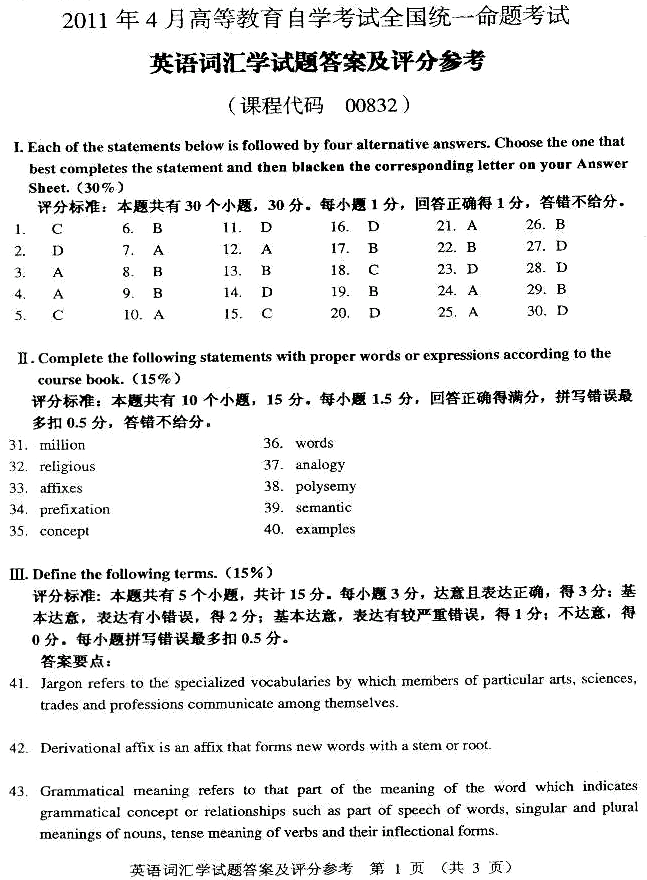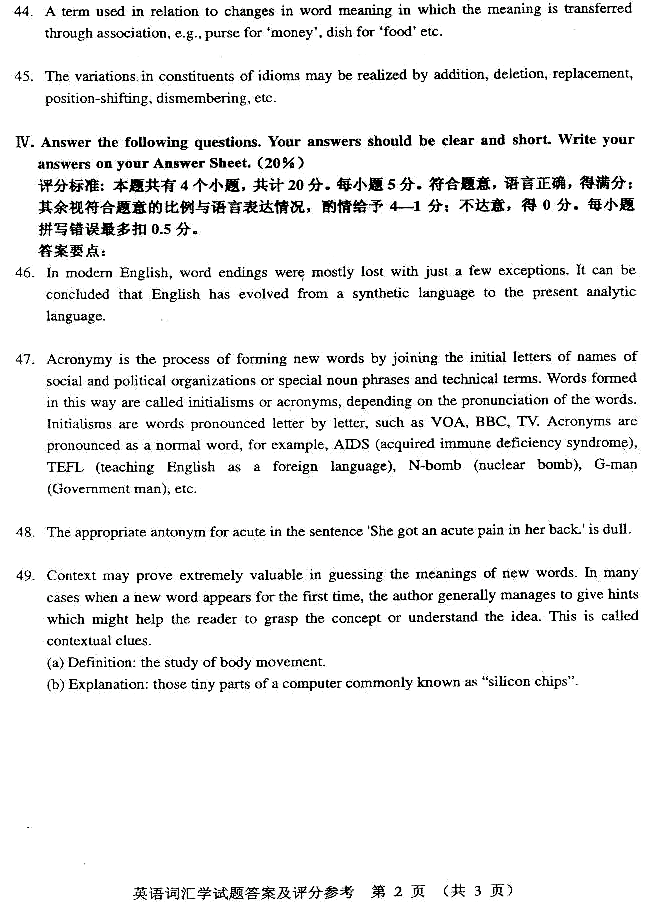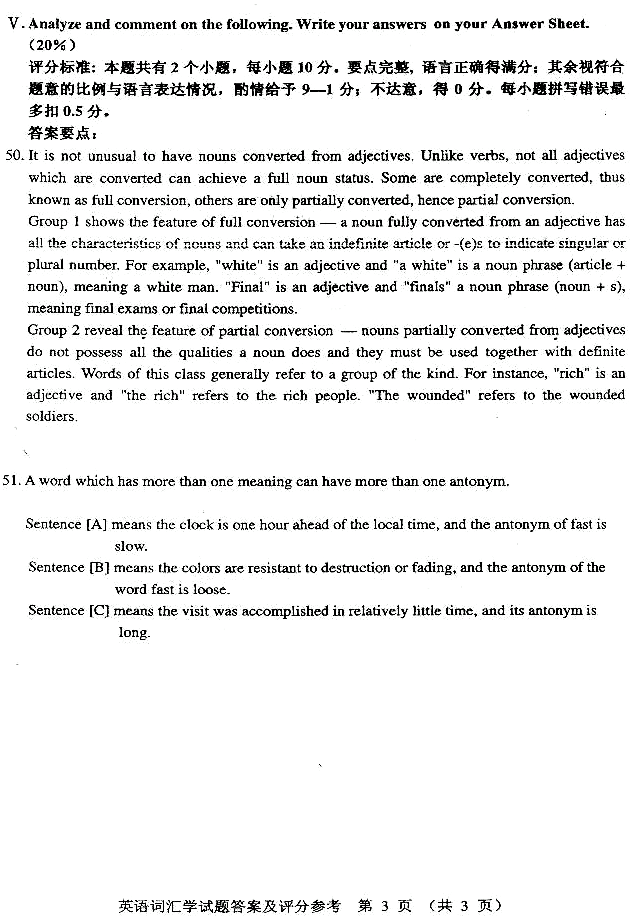全國2011年4月高等教育自學考試
《英語詞匯學》試題和答案
課程代碼:00832
I. Each of the statements below is followed by four alternative answers. Choose the one that best completes the statement and put the letter in the bracket. (30%)
1. The development of English vocabulary can be divided into the following particular historical period EXCEPT ______. ( )
A. Old English B. Middle English
C. New English D. Modern English
2. The definition of a word comprises the following points ______ . ( )
(1) a minimal free form of a language
(2) a sound unity
(3) a unit of meaning
(4) a form that can function alone in a sentence
A. (1) and (2) B. (1) (2) and (3)
C. (2) (3) and (4) D. (1) (2) (3) and (4)
3. Words of the basic word stock can each be used alone, and at the same time can form new words with other roots and affixes, e.g. foot is the father of football, footage and footprint. This demonstrates that one of the characteristics of the words of the basic stock is ______ . ( )
A. productivity B. polysemy
C. stability D. collocability
4. The Indo-European language family is made up of most of the languages of Europe, the Near East, and ______ . ( )
A. India B. the Far East
C. the West Asia D. America
5. In the early period of Modern English, Europe saw a new upsurge of learning ancient Greek and ______ classics. This is known in history as the Renaissance. ( )
A. India B. German
C. Roman D. Chinese
6. Which of the following statements is NOT true? ( )
A. Old English was a highly inflected language.
B. In early Middle English period, English, Latin and Celtic existed side by side.
C. The introduction of printing into England marked the beginning of modern English period.
D. The most important mode of vocabulary development in present-day English is creation of new words by means of word-formation.
7. The smallest functioning unit in the composition of words is ______.( )
A. morpheme B. affixes
C. root D. stem
8. There is/are ______ monomorphemic word(s) in the following words: hot, dog, feet, matches.( )
A. 1 B. 2
C. 3 D. 4
9. The plural morpheme "-s" is pronounced as/s/in the following words EXCEPT ______. ( )
A. packs B. bags
C. cheats D. ships
10. 30% to 40% of the total number of new words in English vocabulary are produced through ______ .( )
A. affixation B. clipping
C. compounding D. shortening
11. The formation of new words by converting words of one class to another class is called ______. ( )
A. prefixation B. suffixation
C. acronymy D. conversion
12. The method of creating words by removing the supposed suffixes is called ______. ( )
A. back-formation B. clipping
C. blending D. suffixation
13. ______ accounts for the connection between the linguistic symbol and its meaning. ( )
A. Sense B. Motivation
C. Concept D. Reference
14. By ______ motivation, we mean that the meaning of a particular word is related to its origin. ( )
A. onomatopoeic B. morphological
C. semantic D. etymological
15. In English there are ______ types of motivation that concerns the relationship between the sign and meaning. ( )
A. 2 B. 3
C. 4 D. 5
16. What is a common feature peculiar to all natural languages? ( )
A. Suffixation. B. Variation.
C. Allomorph. D. Polysemy.
17. Red, scarlet, mauve, violet, lavender, pansy, black, purple, etc, make up the ______ field of ‘colours’. ( )
A. stylistic B. semantic
C. elliptic D. syntactic
18. What is applicable to contradictory terms of some antonyms may NOT be applicable to their ______ terms? ( )
A. connotative B. collocative
C. relative D. negative
19. When a common word is turned into a proper noun, the meaning is ______accordingly. ( )
A. related B. narrowed
C. created D. suggested
20. Which of the following words was used during the American Civil War to refer to those northerners who were secretly aiding the South? ( )
A. Rattlesnake. B. Villain.
C. Informer. D. Copperhead.
21. People change word-meaning owing to various ______ motives: love, respect, courtesy, suspicion, pessimism, sarcasm, irony, contempt, hatred, etc. ( )
A. psychological B. social
C. communicative D. lexical
22. In a narrow sense, context refers to the words, clauses, sentences in which a word appears and is known as ______ context. ( )
A. non-linguistic B. linguistic
C. grammatical D. lexical
23. Which of the following is one of the main functions of verbal context? ( )
A. Elimination of ambiguity.
B. Indication for referents.
C. Provision of clues for inferring word-meaning.
D. All the above.
24. Which of the following is NOT true about extra-linguistic context? ( )
A. It can be subdivided into grammatical context and non-linguistic context.
B. It refers to physical situation or environment relating to the use of words.
C. It embraces the people, time and place.
D. It may extend to embrace the entire cultural background.
25. The idiom "fall into good hands" is a ______ as far as figures of speech are concerned. ( )
A. synecdoche B. metaphor
C. metonymy D. personification
26. "Flesh and blood" is an idiom ______ in nature. ( )
A. verbal B. nominal
C. adjectival D. adverbial
27. The change of idiom "velvet paws" from the original form is ______.( )
A. replacement B. position-shifting
C. addition D. shortening
28. American dictionaries generally use ______ to mark the pronunciation. ( )
A. British Phonetic Alphabet B. American Phonetic Alphabet
C. International Phonetic Alphabet D. Webster's Phonetic Alphabet
29. Which of the following dictionaries is NOT a specialized dictionary? ( )
A. The Oxford Dictionary of English Etymology
B. Chamber's Encyclopaedic English Dictionary
C. Longman Dictionary of Phrasal Verbs
D. Webster's New Dictionary of Synonyms
30. Usage notes of the dictionary explain ______. ( )
A. the slight difference between words of similar meanings
B. difficult points of grammar and style
C. important British and American differences
D. all the above
II. Complete the following statements with proper words or expressions according to the course book. (15 % )
31. The general estimate of the present-day English vocabulary is over one _________ words.
32. At the end of 6
th century, Latin-speaking missionaries under St. Augustine came to spread Christianity in Britain. It brought many new ideas and customs and also many _________ terms such as abbot, candle, altar, etc.
33. The forms that are attached to words or word elements to modify meaning or function are _________.
34. The process of changing the word "possible" into "impossible" is called _________.
35. The synonymous pair "die — pass away" has the same _________ but different stylistic values.
36. Semantically, all _________ are related in one way or another.
37. Fortuitous formerly denoted 'happening by chance', 'accidental' and later took on the meaning 'fortunate' probably by _________ because the two words look similar.
38. The sentence "He is a hard businessman" is ambiguous due to _________.
39. The characteristic of idioms —_________ unity can be reflected by the understanding of such idiom as "rain cats and dogs".
40. Definition, extra column and usage _________ are the unique features of Collins COBUILD English Language Dictionary (1987).
III. Define the following terms. (15%)
41. jargon
42. derivational affix
43. grammatical meaning
44. associated transfer
45. variations of idioms
IV. Answer the following questions. Your answers should be clear and short. Write your answers in the space given below. (20 % )
46. leorn→ian→lern→en→learn
Above is the change of "learn" from Old English through Middle English to Modern English.
What can you conclude from the viewpoint of the development of English vocabulary?
47. Both initialisms and acronyms are formed to a certain extent from initial letters. Is there any difference between them? Illustrate your point with examples.
48. What is the appropriate antonym for acute in the following statement?
She got an acute pain in her back.
49. What are contextual clues?
Guess the meaning of the word underlined in the following sentence and tell what contextual clues have helped you in arriving at the meaning.
(a) Perhaps the most startling theory to come out of kinesics, the study of body movement, was suggested by Professor B irdwhistell.
(b) It's just one more incredible result of the development of microprocessors — those tiny parts of a computer commonly known as "silicon chips".
V. Analyze and comment on the following. Write your answers in the space given below. (20 % )
50. Comment on the following groups to illustrate the difference between partial and full conversion.
Group 1: "white — a white, final — finals"
Group 2: "rich — the rich, wounded — the wounded"
51. Analyze and comment on the meanings of the following sentences and then find out the right antonyms for each fast respectively.
[A] My god, look, this clock is one hour fast, as if we were at Tokyo.
[B] The colors aren't fast, so be careful when you wash this shirt.
[C] The delegation paid a fast visit to the United Kingdom last month.
2010--2015年全國自考《英語詞匯學:00832》1月、4月、10月真題、答案大全。
考生可以登錄湖南大學自考網(http://www.zzzttt64.com/ )的《歷年真題》欄目,免費下載。


 2011年4月全國自考《英語詞匯學:00832》試題和答案:免費下載(word文檔)
2011年4月全國自考《英語詞匯學:00832》試題和答案:免費下載(word文檔)


